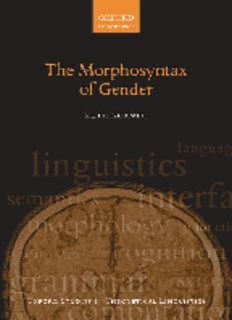
The morphosyntax of gender PDF
Preview The morphosyntax of gender
OUPCORRECTEDPROOF–FINAL,28/7/2015,SPi The Morphosyntax of Gender OUPCORRECTEDPROOF–FINAL,28/7/2015,SPi OXFORD STUDIES IN THEORETICAL LINGUISTICS generaleditors DavidAdgerandHagitBorer,QueenMary,UniversityofLondon advisoryeditors Stephen Anderson, Yale University; Daniel Büring, University of California, Los Angeles;NomiErteschik-Shir,Ben-GurionUniversity;DonkaFarkas,Universityof California, Santa Cruz; Angelika Kratzer, University of Massachusetts, Amherst; AndrewNevins,UniversityCollegeLondon;ChristopherPotts,StanfordUniversity; Barry Schein, University of Southern California; Peter Svenonius, University of Tromsø;MoiraYip,UniversityCollegeLondon recenttitles 43Genericity editedbyAldaMari,ClaireBeyssade,andFabioDelPrete 44StrategiesofQuantification editedbyKook-HeeGil,SteveHarlow,andGeorgeTsoulas 45NonverbalPredication CopularSentencesattheSyntax–SemanticsInterface byIsabelleRoy 46DiagnosingSyntax editedbyLisaLai-ShenChengandNorbertCorver 47PseudogappingandEllipsis byKirstenGengel 48SyntaxanditsLimits editedbyRaffaellaFolli,ChristinaSevdali,andRobertTruswell 49PhraseStructureandArgumentStructure ACaseStudyoftheSyntax–SemanticsInterface byTerjeLohndal 50EdgesinSyntax ScramblingandCyclicLinearization byHeejeongKo 51TheSyntaxofRootsandtheRootsofSyntax editedbyArtemisAlexiadou,HagitBorer,andFlorianSchäfer 52CausationinGrammaticalStructures editedbyBridgetCopleyandFabienneMartin 53ContinuationsandNaturalLanguage byChrisBarkerandChung-chiehShan 54TheSemanticsofEvaluativity byJessicaRett 55ExternalArgumentsinTransitivityAlternations byArtemisAlexiadou,ElenaAnagnostopoulou,andFlorianSchäfer 56ControlandRestructuring byThomasGrano 57TheInteractionofFocusandGivennessinItalianClauseStructure byVieriSamek-Lodovici 58TheMorphosyntaxofGender byRuthKramer Foracompletelistoftitlespublishedandinpreparationfortheseries,seepp287–8. OUPCORRECTEDPROOF–FINAL,28/7/2015,SPi The Morphosyntax of Gender RUTH KRAMER 1 OUPCORRECTEDPROOF–FINAL,28/7/2015,SPi 3 GreatClarendonStreet,Oxfordox26dp UnitedKingdom OxfordUniversityPressisadepartmentoftheUniversityofOxford. ItfurtherstheUniversity’sobjectiveofexcellenceinresearch,scholarship, andeducationbypublishingworldwide.Oxfordisaregisteredtrademarkof OxfordUniversityPressintheUKandincertainothercountries #RuthKramer2015 Themoralrightsoftheauthorhavebeenasserted FirstEditionpublishedin2015 Impression:1 Allrightsreserved.Nopartofthispublicationmaybereproduced,storedin aretrievalsystem,ortransmitted,inanyformorbyanymeans,withoutthe priorpermissioninwritingofOxfordUniversityPress,orasexpresslypermitted bylaw,bylicence,orundertermsagreedwiththeappropriatereprographics rightsorganization.Enquiriesconcerningreproductionoutsidethescopeofthe aboveshouldbesenttotheRightsDepartment,OxfordUniversityPress,atthe addressabove Youmustnotcirculatethisworkinanyotherform andyoumustimposethissameconditiononanyacquirer PublishedintheUnitedStatesofAmericabyOxfordUniversityPress 198MadisonAvenue,NewYork,NY10016,UnitedStatesofAmerica BritishLibraryCataloguinginPublicationData Dataavailable LibraryofCongressControlNumber:2014958986 ISBN 978–0–19–967993–5(Hbk) ISBN 978–0–19–967994–2(Pbk) Printedandboundby CPIGroup(UK)Ltd,Croydoncr04yy LinkstothirdpartywebsitesareprovidedbyOxfordingoodfaithand forinformationonly.Oxforddisclaimsanyresponsibilityforthematerials containedinanythirdpartywebsitereferencedinthiswork. OUPCORRECTEDPROOF–FINAL,28/7/2015,SPi Contents Generalpreface ix Acknowledgments x Listoffiguresandtables xii Listofabbreviations xiii 1 Introduction 1 1.1 Majorthemes 1 1.2 Frameworks:MinimalismandDistributedMorphology 3 1.2.1 Settingthescene 3 1.2.2 AlittleMinimalism,alotofDM 4 1.2.3 Lexicaldecomposition 7 1.2.4 Summary 9 1.3 Limitations 10 1.4 Thelayoftheland:chapterpreviews 11 2 TheAmharicgendersystemandpreviousapproachestogender 14 2.1 Introduction 14 2.2 GenderinAmharic 14 2.2.1 Thefacts 15 2.2.2 Summary,typology,diachrony 20 2.3 Themorphosyntaxofgender:previousapproaches 23 2.3.1 GenPandNumP 24 2.3.2 Genderonthenoun:lexicalism 26 2.3.3 Genderonthenoun:DistributedMorphology 32 3 Ananalysisofgender 37 3.1 Introduction 37 3.2 Themorphosyntaxofgender:anewapproach 37 3.3 Furtherevidencefornasthelocusofgender 42 3.4 Licensingconditionsandinterpretability:refiningtheanalysis 49 3.4.1 Licensingconditions 50 3.4.2 Theinterpretabilityofgenderfeatures 57 3.5 Conclusion 63 OUPCORRECTEDPROOF–FINAL,28/7/2015,SPi vi Contents 4 Defininggender 65 4.1 Whatgenderis,andwhatgenderisn’t 65 4.1.1 Classifiersanddeclensionclassarenotgenders 67 4.1.2 Nounclassandpronominalgenderaregender 68 4.1.3 Genderisnotlikeotherphi-features 69 4.2 Conclusion 71 5 Casestudy1:Twogenders,threens 72 5.1 Introduction 72 5.2 Masculinedefaultorfemininedefault 73 5.2.1 Masculinedefault:Dieri 74 5.2.2 Femininedefault:ZayseandZargulla 79 5.3 Animacy-basedgendersystemsandanegativeprediction 82 5.3.1 Introduction 82 5.3.2 ThegendersystemofLealaoChinantec:description 84 5.3.3 ThegendersystemofLealaoChinantec:analysis 86 5.4 Conclusion 88 6 Casestudy2:Addinganuninterpretablegenderfeature 89 6.1 Introduction 89 6.2 Uninterpretablefemininegender:Spanish 90 6.2.1 ThegendersystemofSpanish:description 90 6.2.2 ThegendersystemofSpanish:analysis 95 6.2.3 ComparingSpanishandAmharic 98 6.3 Uninterpretablemasculinegender:Maa 99 6.3.1 ThegendersystemofMaa:description 100 6.3.2 ThegendersystemofMaa:analysis 104 6.4 Uninterpretableanimacy:Algonquian 105 6.4.1 ThegendersystemofAlgonquian:description 105 6.4.2 ThegendersystemofAlgonquian:analysis 110 6.5 Conclusion 114 7 Casestudy3:Three-genderlanguages 116 7.1 Introduction 116 7.2 Threegenders,threens:Mangarayi 116 7.2.1 ThegendersystemofMangarayi:description 117 7.2.2 ThegendersystemofMangarayi:analysis 118 7.3 Threegenders,oneuninterpretablefeature:Wari’ 121 7.3.1 ThegendersystemofWari’:description 123 7.3.2 ThegendersystemofWari’:analysis 125 OUPCORRECTEDPROOF–FINAL,28/7/2015,SPi Contents vii 7.4 Threegenders,twouninterpretablefeatures:Lavukaleve 129 7.4.1 ThegendersystemofLavukaleve:description 131 7.4.2 ThegendersystemofLavukaleve:analysis 133 7.4.3 Conclusion:Lavukaleve 138 7.5 Conclusion 139 7.6 Excursus:defaultgenderinthree-genderlanguages 140 7.6.1 DefaultgenderinMangarayi,Wari’,andLavukaleve 141 7.6.2 DefaultgenderinRussian,Icelandic,andTamil 142 7.6.3 Suggestionsforanalysisandconclusion 145 8 GenderisnotonNum:EvidencefromSomaliandRomanian 147 8.1 Introduction 147 8.2 GenderswitchinSomali:allpluralsaren 148 8.2.1 GenderinSomali:descriptionandanalysis 149 8.2.2 ThepluralsystemofSomali 151 8.2.3 PluralityisonninSomali:evidence 155 8.2.4 Somalipluralsystem:analysis 159 8.2.5 Alternativeanalysesandconclusions 164 8.3 GenderswitchinRomanian:theneuterisreal 166 8.3.1 TheRomaniangendersystem 166 8.3.2 TheanalysisofRomaniangender 169 8.3.3 Alternativeanalyses 177 8.3.4 Interimconclusion 183 8.4 Conclusion 183 9 Genderandnominalizations 185 9.1 Introduction 185 9.2 Nominalizationsaregendered:data 185 9.2.1 Theoreticalbackground 185 9.2.2 Varioustypesofnominalizationsaregendered 187 9.2.3 Allofthegender-relevantnscannominalize 190 9.3 Nominalizationsaregendered:predictions 192 9.3.1 Derivednounswithoutn 193 9.3.2 Onegender,manyexponents 196 9.3.3 Nominalizationsinananimacygendersystem 200 9.3.4 Interimsummary 204 9.4 Twoproblems(andtheirsolutions) 205 9.4.1 Genderfeaturesexponedseparately? 205 9.4.2 Samenominalization,differentgenders? 209 9.5 Conclusion 212 OUPCORRECTEDPROOF–FINAL,28/7/2015,SPi viii Contents 10 Thehighestgenderwinsandtheinteractionofgenderand declensionclass 213 10.1 Introduction 213 10.2 Maythehighestgenderwin:genderandmultiplens 213 10.2.1 Thehighestgenderwins:data 214 10.2.2 Acyclicityexplanationforthehighestgenderhypothesis 220 10.2.3 Conclusionandimplications 226 10.3 Adiminutivedigression 227 10.4 Declensionclassandgender 233 10.4.1 Background 233 10.4.2 Spanishdeclensionclass:acasestudy 235 10.4.3 Summary,anddirectionsofcorrelations 243 10.5 Conclusion 244 11 Conclusion 245 11.1 Puttingitalltogether 245 11.1.1 QuestionA:Genderonn 245 11.1.2 QuestionB:Therelationshipbetweennaturalandarbitrary gender 247 11.1.3 QuestionC:Genderassignment 248 11.1.4 EvidenceforDistributedMorphology 250 11.2 Areasoffutureresearch 250 11.2.1 Phonologicallydeterminedgenderassignment 250 11.2.2 Languageswithmorethanthreegenders 251 11.2.3 Theroleofsocialfactors 253 11.2.4 Languagesthatlackgender 254 11.3 Meta-conclusion 256 References 257 Indexoflanguagesandlanguagefamilies 281 Subjectindex 284 OUPCORRECTEDPROOF–FINAL,28/7/2015,SPi General preface Thetheoreticalfocusofthisseriesisontheinterfacesbetweensubcomponentsofthe humangrammaticalsystemandthecloselyrelatedareaoftheinterfacesbetweenthe differentsubdisciplinesoflinguistics.Thenotionof“interface”hasbecomecentralin grammaticaltheory(forinstance,inChomsky’sMinimalistProgram)andinlinguis- tic practice: work on the interfaces between syntax and semantics, syntax and morphology, phonology and phonetics, etc. has led to a deeper understanding of particularlinguisticphenomenaandofthearchitectureofthelinguisticcomponent ofthemind/brain. The series covers interfaces between core components of grammar, including syntax/morphology, syntax/semantics, syntax/phonology, syntax/pragmatics, morphology/phonology, phonology/phonetics, phonetics/speech processing, seman- tics/pragmatics,andintonation/discoursestructure,aswellasissuesinthewaythatthe systemsofgrammarinvolvingtheseinterfaceareasareacquiredanddeployedinuse (including language acquisition, language dysfunction, and language processing). It demonstrates, we hope, that proper understandings of particular linguistic phenom- ena, languages, language groups, or inter-language variations all require reference to interfaces. Theseriesisopentoworkbylinguistsofalltheoreticalpersuasionsandschoolsof thought.Amainrequirementisthatauthorsshouldwritesoastobeunderstoodby colleaguesinrelatedsubfieldsoflinguisticsandbyscholarsincognatedisciplines. Gender features stand at the intersection of syntax, semantics, and morphology, andhowtheirroleisdividedbetweenthesethreedomainshaslongbeenapuzzle.In thismonograph,RuthKramerdevelopsanewtheoryofthemorphosyntaxofgender, arguingthat gender features appear not on lexical roots or on elements high in the structureofnounphrases,butonthenominalizingheadn.Shedefendsaparticular theoryofgenderfeaturesbasedonthenotionsofinterpretabilityandbivalence,and showshowthistheorypredictstheattestedtypologicalvariationingendersystems, drawingonfascinatingdatafromanumberoflesserstudiedlanguages.Overall,the bookproposesthefirstcomprehensivetheoryofgenderasaphi-featureingenerative linguistics. DavidAdger HagitBorer
Description: